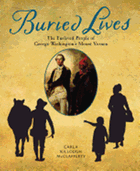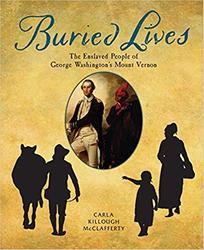
 When he was just 11 years old, George Washington inherited ownership of 10 human beings. By the time he died in 1799, Washington's estate on the Potomac River, Mount Vernon, was home to 317 enslaved African American men, women and children: 123 people owned by Washington, 41 rented from other owners and 153 held by his wife, Martha, as an inheritance from her late first husband.
When he was just 11 years old, George Washington inherited ownership of 10 human beings. By the time he died in 1799, Washington's estate on the Potomac River, Mount Vernon, was home to 317 enslaved African American men, women and children: 123 people owned by Washington, 41 rented from other owners and 153 held by his wife, Martha, as an inheritance from her late first husband.
The irony, of course, was that "the man who led the fight for American freedom" remained a slave owner his entire life. Washington was one of 12 presidents who owned slaves and, despite his well-stated personal objections to slavery, he never applied his influence or power toward abolishing it. In Buried Lives: The Enslaved People of George Washington's Mount Vernon, award-winning nonfiction children's book author Carla Killough McClafferty (The Many Faces of George Washington: Remaking a Presidential Icon) confronts Washington's role as a conflicted slave owner through the stories of six enslaved Mount Vernon residents.
Without the forced labor of the half-dozen African Americans profiled, Washington's life would likely have been quite different. William Lee was Washington's valet, attending to all his personal needs. Lee served Washington valiantly through the Revolutionary War; his intimate knowledge could easily have won him his freedom had he defected to the British army, yet he "stayed with the man who owned him." When severe knee injuries made service impossible for Lee, Christopher Sheels became Washington's personal valet, including the years of Washington's presidency. Caroline, later known as Caroline Branham, was a housemaid in the mansion, and her husband, Peter Hardiman, rented from Martha Washington's son's estate, ran Mount Vernon's large-scale mule-breeding operation. Ona Maria Judge, who began service as a child at Mount Vernon, was Martha's personal maid and accompanied the first First Lady to New York and Philadelphia. Hercules was the renowned "chief cook in the kitchen of the president of the United States" in Philadelphia who impressed dignitaries from all over the world with his culinary prowess.
Relying on extensive research--including Washington's own writings and other first-hand accounts of enslaved life at Mount Vernon--McClafferty provides an alternative history to the existing, too-often idealized founding fathers' mythology. Beyond the biographies, McClafferty continues with "And Then What Happened?," culling additional information about the descendants of the six profilees; Caroline's fourth great-granddaughter, activist and educator ZSun-nee Miller-Matema, wrote the book's foreword. McClafferty devotes multiple chapters to the recent archeological reclamation and restoration, begun in 2014, of the unmarked, untended-for-almost-two-centuries burial site of Mount Vernon's enslaved. She further illuminates her words with drawings, maps, newspaper clippings, photographs and other relevant documents that enhance an already compelling, necessary narrative. McCafferty's Buried Lives is long overdue, careful testimony for a new generation of questioning, challenging readers. --Terry Hong, Smithsonian BookDragon
Shelf Talker: Carla Killough McClafferty's illuminating history of slavery at George Washington's iconic Mount Vernon focuses on six African Americans enslaved to the first First Family.

